Prepared for:
Public Services and Procurement Canada
tpsgc.porcoordcomm-ropcoordcomm.pwgsc@tpsgc-pwgsc.gc.ca
Final Report
Prepared by:
EKOS Research Associates, Inc.
359 Kent Street, Suite 300
Ottawa, Ontario
K2P 0R6
Ce rapport est aussi disponible en français.
I hereby certify as Senior Officer of EKOS Research Associates, Inc. that the deliverables fully comply with the Government of Canada political neutrality requirements outlined in the Policy on Communications and Federal Identity and the Directive on the Management of Communications.
Specifically, the deliverables do not include information on electoral voting intentions, political party preferences, standings with the electorate, or ratings of the performance of a political party or its leaders.
Signed:
![]()
Will Daley
Vice President
EKOS Research Associates, Inc.
Public Services and Procurement Canada (PSPC) operates the Contract Security Program (CSP), which provides contract security screening of organizations and their personnel doing business with the Government of Canada.
As part of its effort to improve its practices, the CSP commissioned EKOS Research Associates to conduct research amongst a target audience of organizations currently registered with the Program.
The survey was designed to establish baseline information from organizations registered with the CSP in a variety of areas:
The ultimate objectives served by the major lines of inquiry identified above are to establish and track key performance indicators (KPIs) to assess over time whether CSP program outcomes are improving in the following ways:
By establishing these KPIs, the CSP will be able to determine through future survey research the extent to which changes to the services it offers result in improvements to the cost and service that its client organizations experience.
EKOS Research conducted 451 interviews online (an average time of 15 minutes was required to complete the survey) between January 10 and February 1, 2018, amongst a sample of organizations registered with the CSP. This sample was identified from a sample frame of 2,319 which was randomly selected from a universe of 22,716 organizations registered with the CSP.
A sample of n=451 obtains a margin of error of +/ -4.6 percentage points (calculated at a 95% confidence interval). The margin of error means that the results of the research are, theoretically, within 4.6 percentage points (higher or lower) of the results if the entire population had been surveyed. A larger sample size would result in a lower margin of error.
Tables included in the Detailed Methodology (within the Appendices) outline the size and regional distribution of the universe, sample frame and sample, both weighted and unweighted.
The final value of this contract, including the harmonized sales tax, is $14,571.35.
A majority of CSP clients say they access the Online Industrial Security Services (OLISS) portal at least once per month (59%), including three in ten (29%) who use the OLISS Portal at least once per week. Two in three respondents (68%) say they are familiar with OLISS (including 34% who are ‘very’ familiar).
Just over half of respondents (54%) agree that the information provided was organized in a clear manner, while a similar proportion (53%) offered a positive appraisal of the clarity of the information itself. Half (49%) award the portal positive marks in terms of ease of finding the needed information. Relatively few respondents (14% to 16%) indicated that they were dissatisfied with the OLISS Portal.
Two in three respondents (69%) say that tools were made available to them by the CSP when they submitted a new security application. Among those who were given access to these tools, most recall being granted access to instructions (70%) and online resources (64%). About half recall being offered guides (54%), the Industrial Security Manual (52%), or checklists (51%). Among those who had access to these resources, six in ten (63%) would rate them as helpful. Nearly one in three (30%) rated the tools as neutral, (6%) not very helpful, and (1%) not at all helpful.
Four in ten respondents have either been involved in an inspection of their facility by a CSP officer (41%), have participated in an in-person training session (45%), or have taken part in a webinar (39%).
The findings show that experience with an inspection and taking part in training (either in person or online) help clarify the safeguarding requirements. Among those who have been involved in an inspection by a CSP officer, nine in ten (89%) found that the experience made the requirements more clear. Similarly, eight in ten in-person training session attendees (81%) agreed that the experience clarified the requirements. Among those who participated in a webinar training seminar, three-quarters (73%) found the session helpful.
Two in three respondents (65%) who received an invitation to a webinar training session, but could not attend say they were interested, while one in four (25%) were not. Three in five respondents invited to an in-person training session (58%) say they were interested in attending, compared to one in three (36%) who were not.
The CSP generally scores well in terms of level of service, although responses suggest room for improvement when it comes to timeliness and ease of access. The vast majority of respondents (87%) are satisfied with the respectfulness of CSP staff. Similarly, about seven in ten are satisfied with the CSP staff’s knowledge (72%), ease of obtaining service (68%), and how well CSP staff understood their needs (66%). Six in ten are pleased with the clarity of the information they received (61%) and the effectiveness of CSP communications (59%).
The CSP received somewhat more mixed reviews when it comes to ease of access and timeliness. While half of respondents (49%) say they are satisfied with their ability to access CSP services, one in five (22%) indicate that they are dissatisfied. Similar proportions indicated satisfaction with the time it took to get a response (48%) and the time it took to receive service (46%), although roughly three in ten provided negative assessments (27% and 29%, respectively).
Nearly one in three respondents (28%) said their organization files five or fewer CSP applications (reliability or classified) in a typical year. One in five (21%) said they file between five and 10 CSP applications per year, while a similar proportion (19%) files between 10 and 20 per year. One-third (32%) usually files 20 or more.
One in four respondents (24%) indicated that they typically file five or fewer security applications (for either the CSP or another government department) during a typical yearFootnote 1. One in five (19%) said they usually file between five and 10 applications, while one in four (23%) file between 10 and 20. One-third (34%) said they generally file 20 or more.
About eight in ten respondents (83%) indicated that they file at least one reliability status application through the CSP per year and those who did reported a median of 10 such applications. Half (51%) usually file at least one classified application through the CSP with a median of five applications per year. One-quarter (28%) generally apply for at least one security screening application for a government department (whether reliability or classified) outside the CSP; the median number of reported applications is five.
Clients report spending an average of 1.4 hours completing a reliability status application. Classified applications, meanwhile, take about twice as long to complete (with a reported average completion time of 2.7 hours).
Respondents express fairly limited knowledge of the processes involved in sponsoring companies as subcontractors to work on government contracts that include security requirements. Just three in ten (28%) would consider themselves knowledgeable of the processes involved, while four in ten (40%) say they are not very or not at all knowledgeable.
The Contract Security Program’s Online Industrial Security Services (OLISS) Portal allows authorized users to access a number of services online. This section measures use of the portal, as well as its perceived clarity and ease of use.
Those who have registered with the Contract Security Program (CSP) access the OLISS Portal with varying regularity, although the majority use the service at least once per month. Three in ten (29%) use the OLISS Portal at least once per week (including 11% who use it on a daily basis). A similar proportion (30%) access the portal at least once a month and one-quarter – 26% – use the service every three to six months. Just one in eight (12%) use the OLISS Portal once a year or less.
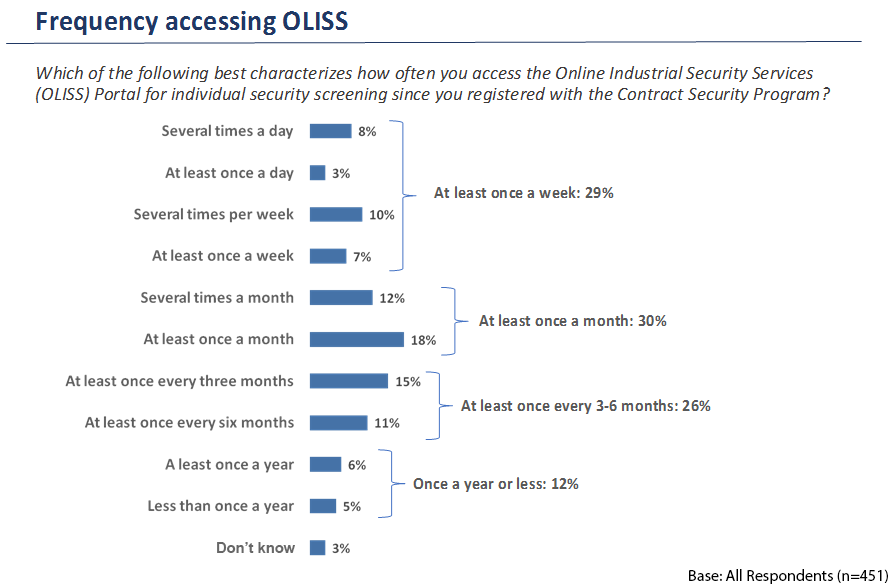
Which of the following best characterizes how often you access the Online Industrial Security Services (OLISS) Portal for individual security screening since you registered with the Contract Security Program (CSP)?
| Several times a day | 8% |
| At least once a day | 3% |
| Several times per week | 10% |
| At least once a week | 7% |
| Several times a month | 12% |
| At least once a month | 18% |
| At least once every three months | 15% |
| At least once every six months | 11% |
| A least once a year | 6% |
| Less than once a year | 5% |
| Don't know | 3% |
Base: All Respondents (n=451)
Perhaps not surprisingly, frequency of use rises with number of employees. For instance, nearly half of ‘large’ firms (i.e., firms that employ 100 or more workers) – 46% – access the OLISS Portal at least once per week, compared to just 14% of ‘small’ firms (i.e., firms with 10 or fewer employees).

How familiar are you with OLISS for individual security screening applications? Please respond on a scale of 1 to 5, where 1 means “not at all familiar” and 5 means “very familiar.”
| Very familiar | 34% |
| Somewhat familiar | 34% |
| Neutral | 20% |
| Not very familiar | 6% |
| Not at all familiar | 6% |
| Don't know | 1% |
| Familiar | 68% |
| Not Familiar | 12% |
Base: All Respondents (n=451)
Familiarity with the OLISS Portal is notably lower in Quebec (49% say they are familiar, compared to 62% to 78% elsewhere in Canada).
Given that larger firms use the service on a more frequent basis, it is not surprising that familiarity with the OLISS Portal is also strongly correlated with firm size. Eight in ten large firms (79%) rate their familiarity as high, a figure that drops to 58% among small firms.
The OLISS Portal scores moderately well in terms of its perceived clarity and ease of use. Just over half of respondents (54%) agree that the information provided was organized in a clear manner, while a similar proportion (53%) offered a positive appraisal of the clarity of the information itself. Half (49%) award the portal positive marks in terms of ease of finding the needed information. Relatively few respondents (14% to 16%) indicated that they were dissatisfied with the OLISS Portal.
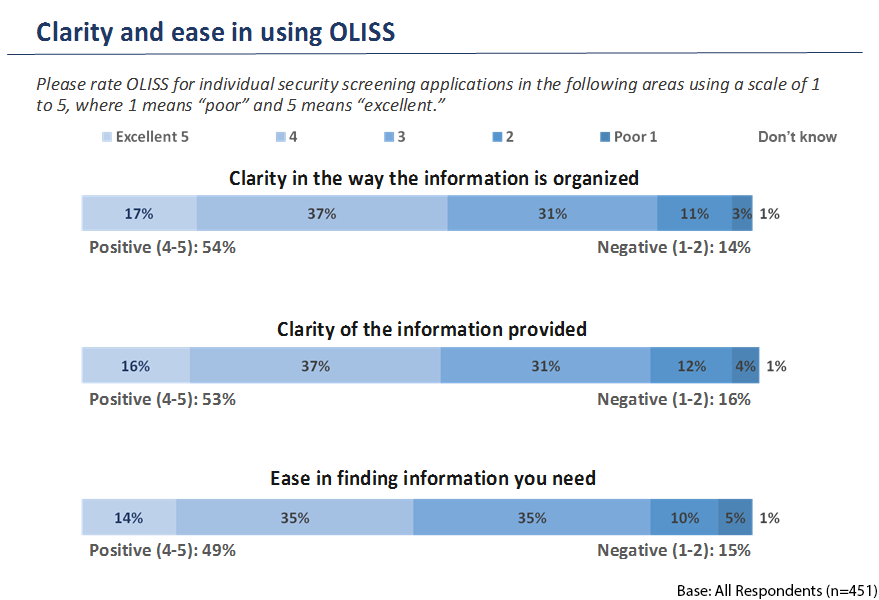
Please rate OLISS for individual security screening applications in the following areas using a scale of 1 to 5, where 1 means “poor” and 5 means “excellent.”
| Excellent 5 | 17% |
| 4 | 37% |
| 3 | 31% |
| 2 | 11% |
| Poor 1 | 3% |
| Don't know | 1% |
| Positive (4-5) | 54% |
| Negative (1-2) | 14% |
| Excellent 5 | 16% |
| 4 | 37% |
| 3 | 31% |
| 2 | 12% |
| Poor 1 | 4% |
| Don't know | 1% |
| Positive (4-5) | 53% |
| Negative (1-2) | 16% |
| Excellent 5 | 14% |
| 4 | 35% |
| 3 | 35% |
| 2 | 10% |
| Poor 1 | 5% |
| Don't know | 1% |
| Positive (4-5) | 49% |
| Negative (1-2) | 15% |
Base: All Respondents (n=451)
To help its clients navigate the application process, the Contract Security Program (CSP) offers a variety of tools, including guides, checklists, instructions, the Industrial Security Manual, and various online resources. This section looks at respondents’ experiences with these resources.
Fully two-thirds of respondents (69%) say that the tools offered by the CSP were made available to them when they submitted a new security application. One in ten (11%), however, claim they were not offered these resources. One in five (20%) do not recall.
Among those who were given access to these tools, most recall being granted access to instructions (70%) and online resources (64%). About half recall being offered guides (54%), the Industrial Security Manual (52%), or checklists (51%).
The results show that these tools are widely regarded to be at least somewhat useful. Among those who had access to these resources, six in ten (63%) would rate them as helpful. Nearly one in three (30%) rated the tools as neutral, (6%) not very helpful, and (1%) not at all helpful.
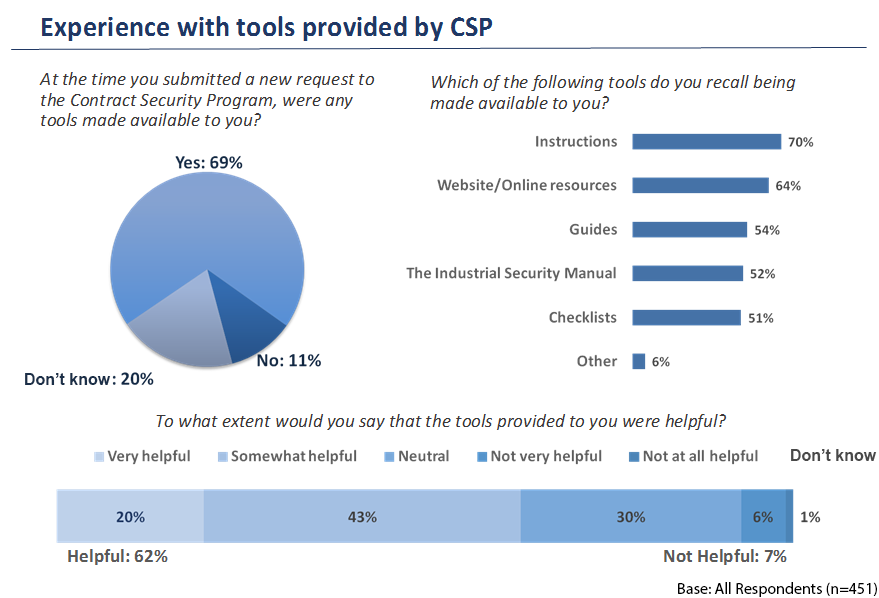
| Yes | 69% |
| No | 11% |
| Don't know | 20% |
| Instructions | 70% |
| Website/Online resources | 64% |
| Guides | 54% |
| The Industrial Security Manual | 52% |
| Checklists | 51% |
| Other | 6% |
| Very helpful | 20% |
| Somewhat helpful | 43% |
| Neutral | 30% |
| Not very helpful | 6% |
| Not at all helpful | 1% |
| Don't know | 1% |
| Helpful | 62% |
| Not Helpful | 7% |
Base: All Respondents (n=451)
Clients based in Ontario are more likely to rate these tools as helpful (72%, compared to 52% to 63% elsewhere in Canada).
In this section, respondents are asked about their experiences with inspections and training sessions—both in-person and online—and whether they would be interested in participating in future training opportunities.
Four in ten respondents (41%) have been involved in an inspection of their facility by a CSP inspection officer, while about half (53%) have not.
More than four in ten respondents (45%) have participated in an in-person training session. One in five (22%) recall receiving an invitation but opted not to participate and one-third (34%) either did not receive an invitation or are uncertain.
Four in ten (39%) have participated in a webinar training session, although the plurality (46%) received an invitation and did not participate. One in seven (15%) either did not receive an invitation or do not recall either way.

| Yes | 41% |
| No | 53% |
| Don't know | 6% |
| Participated | 45% |
| Received invitation | 22% |
| Not Aware/Don't know | 34% |
| Participated | 39% |
| Received invitation | 46% |
| Not Aware/Don't know | 15% |
Base: All Respondents (n=451)
Clients based in Ontario are more likely to have taken part in an inspection (50%) and a webinar training session (49%). Atlantic Canadians (46%) are also more likely to have participated in a webinar.
Large firms (100 or more employees) are more likely to have experienced an inspection (59% compared to 21% among small firms of 10 or fewer employees). Large firms are also more likely to have participated in either in-person or webinar training sessions.
Results suggest that inspections and, to a somewhat lesser extent, training sessions have been widely successful in improving the understanding of the Government of Canada’s information safeguarding requirements. Among those who had been involved in an inspection by a CSP officer, nine in ten (89%) found that the experience clarified the requirements. Similarly, eight in ten in-person training session attendees (81%) agreed that the experience clarified the requirements. Among those who participated in a webinar training seminar, three-quarters (73%) found the session helpful. Very few participants (3% to 5%) found these sessions to be counterproductive.

| More clear 5 | 49% |
| 4 | 40% |
| 3 | 9% |
| 2 | 1% |
| 1 | 2% |
Base: Had an inspection (n=187)
| More clear 5 | 29% |
| 4 | 52% |
| 3 | 15% |
| 2 | 2% |
| 1 | 1% |
Base: Participated in an in-person training session (n=206)
| More clear | 21% |
| 4 | 52% |
| 3 | 22% |
| 2 | 3% |
| 1 | 2% |
Base: Participated in a webinar (n=177)
Results reveal broad interest in participating in training sessions and further suggest that scheduling conflicts are the main culprit driving nonattendance. Among those who recall receiving a webinar training session but who did not attend, two-thirds (65%) indicated that they would have liked to participate, while one-quarter (25%) were not interested. Similarly, three in five respondents invited to an in-person training session (58%) say they were interested in attending, compared to one in three (36%) who were not.
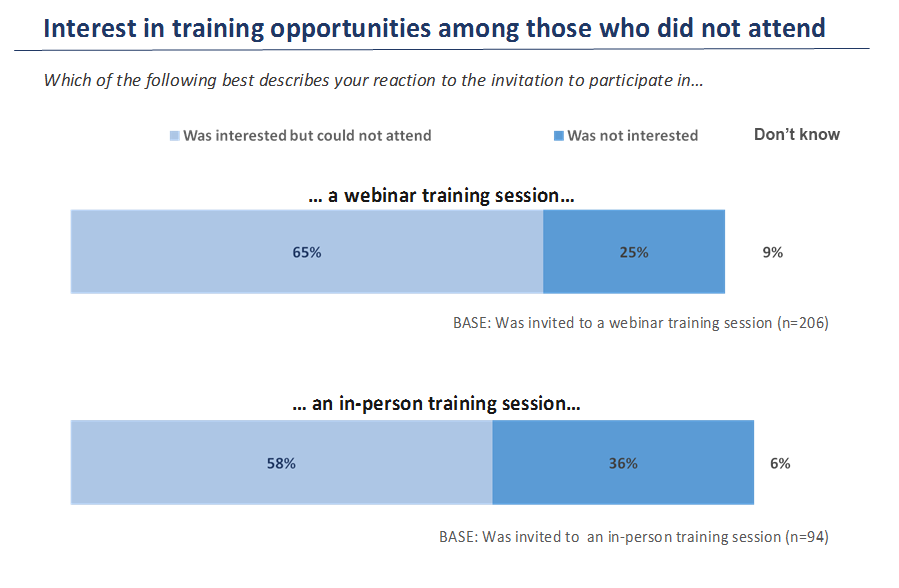
| Was interested, but could not attend | 65% |
| Was not interested | 25% |
| Don't know | 9% |
Base: Was invited to a webinar training session (n=206)
| Was interested, but could not attend | 58% |
| Was not interested | 36% |
| Don't know | 6% |
Base: Was invited to an in-person training session (n=94)
The CSP generally scores well in terms of level of service, although responses suggest room for improvement when it comes to timeliness and ease of access. The vast majority of respondents (87%) are satisfied with the respectfulness of CSP staff. Similarly, about seven in ten are satisfied with the CSP staff’s knowledge (72%), ease of obtaining service (68%), and how well CSP staff understood their needs (66%). Six in ten are pleased with the clarity of the information they received (61%) and the effectiveness of CSP communications (59%).
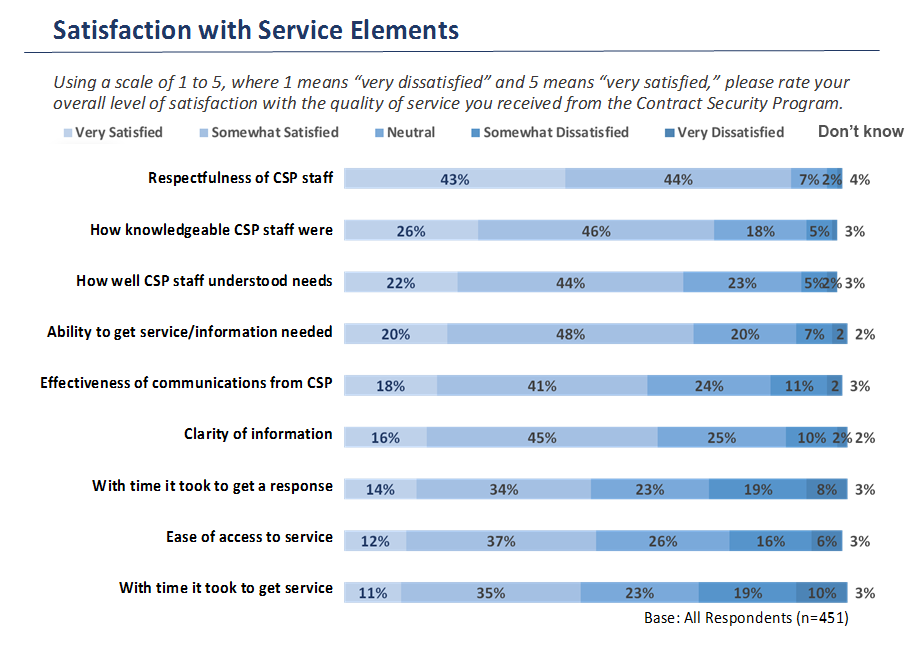
Using a scale of 1 to 5, where 1 means “very dissatisfied” and 5 means “very satisfied,” please rate your overall level of satisfaction with the quality of service you received from the Contract Security Program in each of the following areas.
| Very Satisfied | 43% |
| Somewhat Satisfied | 44% |
| Neutral | 7% |
| Somewhat Dissatisfied | 2% |
| Very Dissatisfied | 1% |
| Don't know | 4% |
| Very Satisfied | 26% |
| Somewhat Satisfied | 46% |
| Neutral | 18% |
| Somewhat Dissatisfied | 5% |
| Very Dissatisfied | 1% |
| Don't know | 3% |
| Very Satisfied | 22% |
| Somewhat Satisfied | 44% |
| Neutral | 23% |
| Somewhat Dissatisfied | 5% |
| Very Dissatisfied | 2% |
| Don't know | 3% |
| Very Satisfied | 20% |
| Somewhat Satisfied | 48% |
| Neutral | 20% |
| Somewhat Dissatisfied | 7% |
| Very Dissatisfied | 2% |
| Don't know | 2% |
| Very Satisfied | 18% |
| Somewhat Satisfied | 41% |
| Neutral | 24% |
| Somewhat Dissatisfied | 11% |
| Very Dissatisfied | 2% |
| Don't know | 3% |
| Very Satisfied | 16% |
| Somewhat Satisfied | 45% |
| Neutral | 25% |
| Somewhat Dissatisfied | 10% |
| Very Dissatisfied | 2% |
| Don't know | 2% |
| Very Satisfied | 14% |
| Somewhat Satisfied | 34% |
| Neutral | 23% |
| Somewhat Dissatisfied | 19% |
| Very Dissatisfied | 8% |
| Don't know | 3% |
| Very Satisfied | 12% |
| Somewhat Satisfied | 37% |
| Neutral | 26% |
| Somewhat Dissatisfied | 16% |
| Very Dissatisfied | 6% |
| Don't know | 3% |
| Very Satisfied | 11% |
| Somewhat Satisfied | 35% |
| Neutral | 23% |
| Somewhat Dissatisfied | 19% |
| Very Dissatisfied | 10% |
| Don't know | 3% |
Base: All Respondents (n=451)
The CSP received somewhat more mixed reviews when it comes to ease of access and timeliness. While half of respondents (49%) say they are satisfied with their ability to access CSP services, one in five (22%) indicate that they are dissatisfied. Similar proportions indicated satisfaction with the time it took to get a response (48%) and the time it took to receive service (46%), although roughly three in ten provided negative assessments (27% and 29%, respectively).
Nearly one in three respondents (28%) said their organization files five or fewer CSP applications in a typical year. One in five (21%) said they file between five and 10 CSP applications per year, while a similar proportion (19%) files between 10 and 20 per year. One-third (32%) usually files 20 or more.
One in four respondents (24%) indicated that they typically file five or fewer security applications (for either the CSP or another government department) during a typical yearFootnote 2. One in five (19%) said they usually file between five and 10 applications, while one in four (23%) file between 10 and 20. One-third (34%) said they generally file 20 or more.
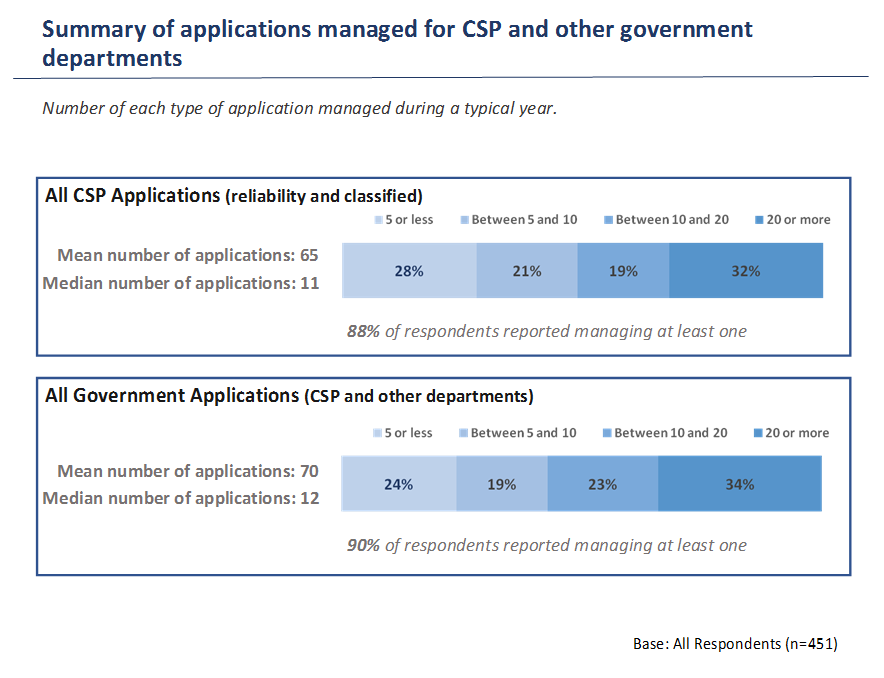
| Mean number of applications per year | 65 |
| Median number of applications per year | 11 |
| Mean number of applications per year | 70 |
| Median number of applications per year | 12 |
| 5 or less | 28% |
| Between 5 and 10 | 21% |
| Between 10 and 20 | 19% |
| 20 or more | 32% |
| 5 or less | 24% |
| Between 5 and 10 | 19% |
| Between 10 and 20 | 23% |
| 20 or more | 34% |
Base: All Respondents (n=451)
About eight in ten respondents (83%) indicated that they file at least one reliability status application through the CSP per year and those who did reported a median of 10 such applications. Half (51%) usually file at least one classified application through the CSP with a median of five applications per year. One-quarter (28%) generally apply for at least one security screening application for a government department (whether reliability or classified) outside the CSP; the median number of reported applications is five.
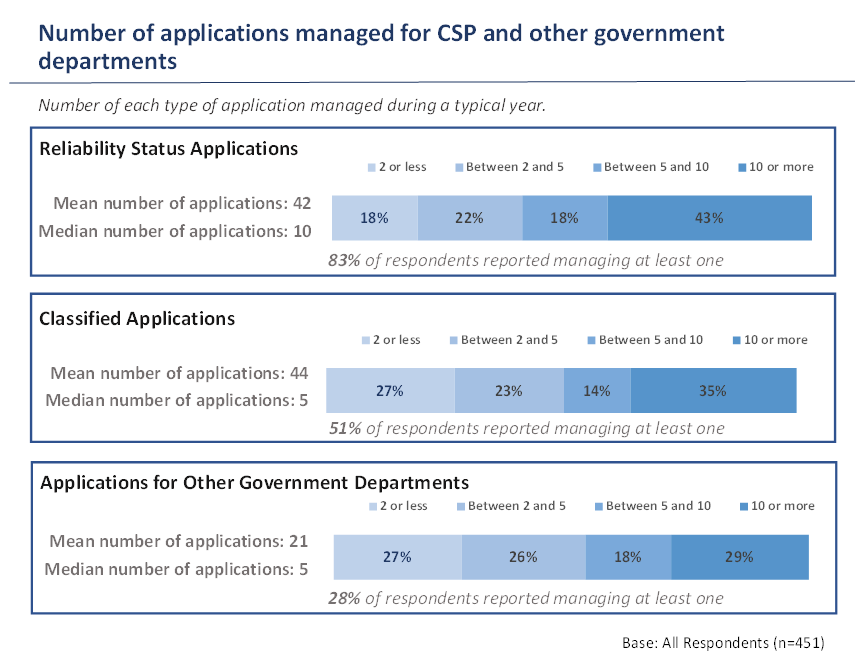
| Mean number of applications per year | 42 |
| Median number of applications per year | 10 |
| Mean number of applications per year | 44 |
| Median number of applications per year | 5 |
| Mean number of applications per year | 21 |
| Median number of applications per year | 5 |
| 2 or less | 18% |
| Between 2 and 5 | 22% |
| Between 5 and 10 | 18% |
| 10 or more | 43% |
| 2 or less | 27% |
| Between 2 and 5 | 23% |
| Between 5 and 10 | 14% |
| 10 or more | 35% |
| 2 or less | 27% |
| Between 2 and 5 | 26% |
| Between 5 and 10 | 18% |
| 10 or more | 29% |
Base: All Respondents (n=451)
Clients report spending an average of 1.4 hours completing a reliability status application. Classified applications, meanwhile, take about twice as long to complete (with a reported average completion time of 2.7 hours).
Turning to the time it takes to process these applications, half of respondents (50%) say that reliability status applications are generally processed within one month (including 18% who say two weeks or less). Three in ten (29%) report a typical turnaround time of one to three months and one in seven (14%) would estimate the average processing time at three months or more.
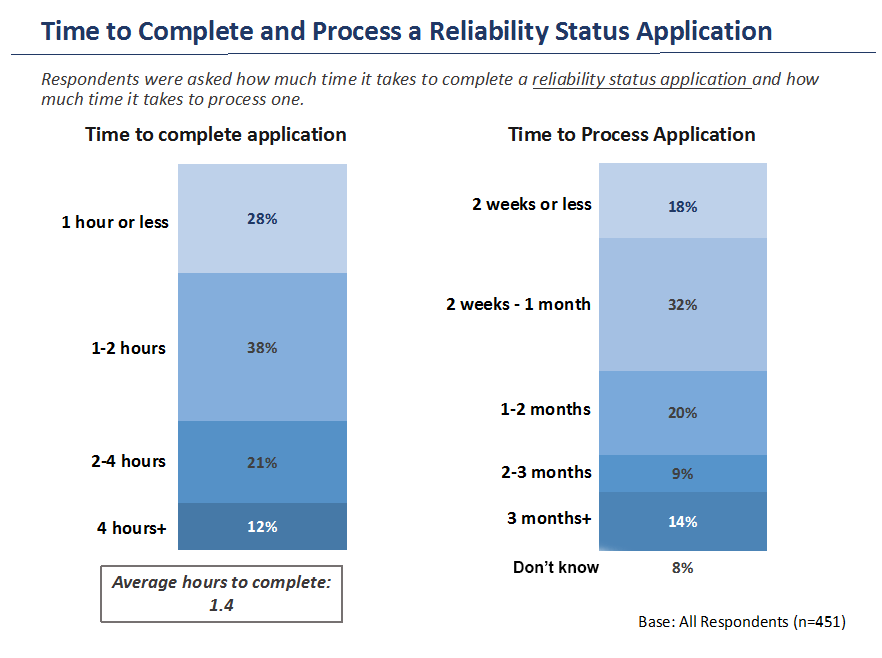
Respondents were asked how much time it takes to complete a reliability status application and how much time it takes to process one.
| 1 hour or less | 28% |
| 1 to 2 hours | 38% |
| 2 to 4 hours | 21% |
| 4 hours or more | 12% |
| Average hours to complete | 1.4 |
| 2 weeks or less | 18% |
| Between 2 weeks and 1 month | 32% |
| Between 1 and 2 months | 20% |
| Between 2 and 3 months | 9% |
| More than 3 months | 14% |
| Don't know/ No response | 8% |
Base: All Respondents (n=451)
Classified applications, in turn, take considerably longer to process. About one-third of respondents (36%) report that the process takes at least three months. One in six (16%) report a typical processing time of one to three months and just seven per cent estimate their timeframe to be less than one month. The plurality of respondents (42%) did not provide an estimate.
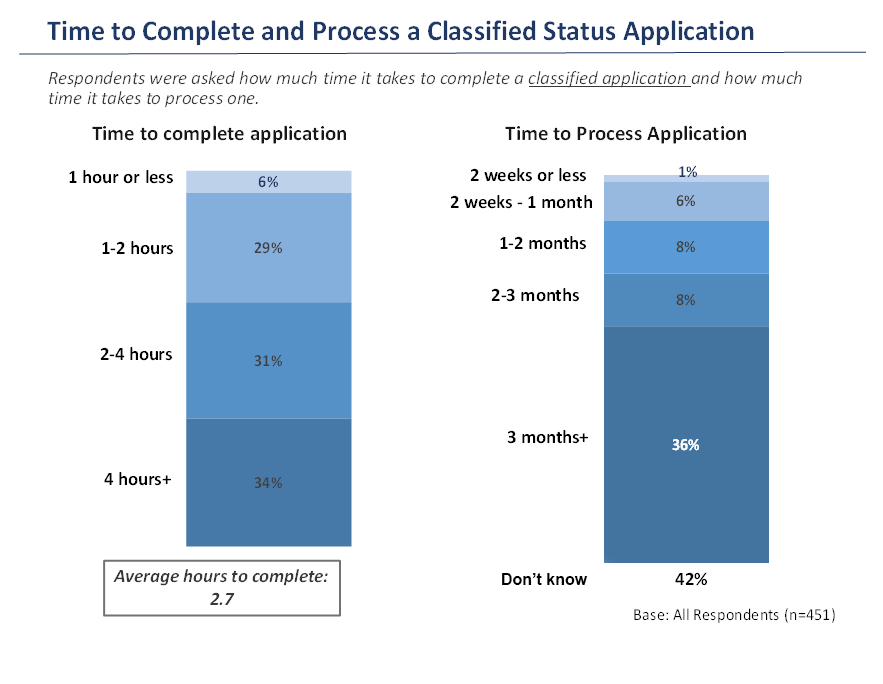
Respondents were asked how much time it takes to complete a classified application and how much time it takes to process one.
| 1 hour or less | 6% |
| Between 1 and 2 hours | 29% |
| Between 2 and 4 hours | 31% |
| More than 4 hours | 34% |
| Average hours to complete | 2.7 |
| 2 weeks or less | 1% |
| Between 2 weeks and 1 month | 6% |
| Between 1 and 2 months | 8% |
| Between 2 and 3 months | 8% |
| More than 3 months | 36% |
| Don't know/ No response | 42% |
Base: All Respondents (n=451)
Respondents express fairly limited knowledge of the processes involved in sponsoring companies as subcontractors to work on government contracts that include security requirements. Just three in ten (28%) would consider themselves knowledgeable of the processes involved, while four in ten (40%) say they are not very or not at all knowledgeable.

How would you rate your knowledge of the processes involved to help you sponsor companies as subcontractors to work with you on a Government of Canada or foreign government contract with security requirements?
| Very knowledgeable | 8% |
| Somewhat knowledgeable | 20% |
| Neutral | 24% |
| Not very knowledgeable | 19% |
| Not at all knowledgeable | 21% |
| Don't know/ Not sure | 9% |
| Knowledgeable | 28% |
| Not knowledgeable | 40% |
Base: All Respondents (n=451)
Ontario-based clients are somewhat more likely to rate their knowledge as high (34%, compared to 21% to 25% elsewhere).
EKOS Research conducted 451 interviews online between January 10 and February 1, 2018, amongst a sample of organizations registered with the CSP. This sample was identified from a sample frame of 2,319 which was randomly selected from a universe of 22,716 organizations registered with the CSP.
A sample of n=451 obtains a margin of error of +/ -4.6 percentage points (calculated at a 95% confidence interval). The margin of error means that the results of the research are, theoretically, within 4.6 percentage points (higher or lower) of the results if the entire population had been surveyed. A larger sample size would result in a lower margin of error.
The table below provides a provincial breakdown of the size of the universe and the sample frame drawn from it. The sample frame over-represented respondents from Quebec in view of lower response rates experienced from this province.
| Registered Organizations | Sample Frame | |||
|---|---|---|---|---|
| Count | % | Count | % | |
| Total | 22766 | -- | 2409 | -- |
| British Columbia | 2372 | 10% | 209 | 9% |
| Alberta | 1794 | 8% | 119 | 5% |
| Saskatchewan | 462 | 2% | 24 | 1% |
| Manitoba | 629 | 3% | 43 | 2% |
| Ontario | 10562 | 46% | 1053 | 44% |
| Quebec | 4472 | 20% | 744 | 31% |
| New Brunswick | 595 | 3% | 61 | 3% |
| Nova Scotia | 1137 | 5% | 122 | 5% |
| PEI | 141 | 1% | 5 | 0% |
| Newfoundland | 429 | 2% | 21 | 1% |
| Nunavut | 32 | 0% | 1 | 0% |
| NWT | 93 | 0% | 3 | 0% |
| Yukon | 48 | 0% | 4 | 0% |
The table below indicates the final unweighted and weighted sample sizes. Weights were applied to correct the sample based on the regional proportions of the population as a whole. As the table below indicates, the weighting only slightly impacts the regional proportions of the unweighted sample.
| Unweighted | Weighted | |||
|---|---|---|---|---|
| Count | % | Count | % | |
| Total | 451 | -- | 451 | -- |
| British Columbia | 40 | 9% | 47 | 10% |
| Alberta | 28 | 6% | 36 | 8% |
| Saskatchewan | 7 | 2% | 9 | 2% |
| Manitoba | 13 | 3% | 12 | 3% |
| Ontario | 221 | 49% | 210 | 47% |
| Quebec | 85 | 19% | 88 | 20% |
| New Brunswick | 11 | 2% | 12 | 3% |
| Nova Scotia | 36 | 8% | 23 | 5% |
| PEI | 0 | 0% | 0 | 0% |
| Newfoundland | 3 | 1% | 8 | 2% |
| Nunavut | 1 | 0% | 1 | 0% |
| NWT | 1 | 0% | 2 | 0% |
| Yukon | 3 | 1% | 1 | 0% |
| Outside Canada | 2 | 0% | 2 | 0% |
The potential for non-response bias exists in this sample based on any number of attributes of the population that are unknown. A few potential areas of non-response bias include company size and industry sector. As neither of these characteristics are documented within the database containing the universe of 22,766 companies registered with the CSP, it is impossible to know how closely the sample characteristics in these respects align with the population itself. As a recommendation for future research, gathering information from registered companies about their company size and industry sector would help to better understand the relationship of a sample like this one to the population of study.
The following response rate calculation is derived from the Marketing Research and Intelligence Association’s empirical method of calculating response rates.
| Sample Frame | 2,409 |
| Invalid/Undeliverable records | 19 |
| Unresolved records (U) Sent successfully without response |
1,849 |
| In-scope, non-responding (IS) | 110 |
| Refused to participate | 43 |
| Started, but did not complete | 67 |
| Completed surveys (R) | 451 |
| Response Rate = R ÷ (U + IS + R) | 19% |
Thank you for participating in this survey. It should take approximately 15 minutes to complete. If you need to stop and return to the survey later, you may do so. However, you must complete the survey on this computer.
As a reminder, your participation in the survey is voluntary – you may stop answering at any time – and confidential – EKOS Research Associates will not share any information that would identify you or your company individually in association with your responses.
If you have any questions about how to answer the survey, please contact … at the following address:
If you feel that you have received this email in error, or have other questions about the survey, please contact … at the following address:
CLICK TO CONTINUE
Provision of the personal information is collected on a voluntary basis pursuant to the Financial Administration Act . Personal information is anonymized by the system. As part of its examination of the contract security screening process to help improve its practices, the Industrial Security Sector of Public Services and Procurement Canada (PSPC) will use the anonymous data to assess the efficiency and effectiveness of contract security services, and cost to companies, in order to offer a valid basis of comparison later on. The information collected is described under the Standard Personal Information Bank Public Communication PSU 914. Your personal information is protected, used, and disclosed in accordance with the Privacy Act . Please do not disclose unnecessary confidential information about yourself or other individual. If you require clarification about this notice, you can contact the Public Services and Procurement Canada (PSPC) Privacy Director by email at aiprp.atip@tpsgc-pwgsc.gc.ca; by phone at 873-469-3721, or by regular mail at the following address: Privacy Director, Place du Portage, Phase III, 5C1, 11 Laurier Street, Gatineau, Quebec, K1A 0S5. If you are not satisfied with our response to your privacy concern, you may wish to contact the Office of the Privacy Commissioner of Canada.
1. Which of the following best describes your business sector as a supplier to the Government of Canada? Please choose one.
2. What is your company size?
3. When it comes to dealing with the Government of Canada on the security clearance process, which of the following best describes your role?
4. Please indicate the province or territory where you work.
5. Which of the following best characterizes how often you access the Online Industrial Security Services (OLISS) Portal for individual security screening since you registered with the Contract Security Program?
6. What is the main activity/function you complete when accessing OLISS for individual security screening?
Based on the amount of effort you put into managing one individual security screening, please provide the information requested below for Reliability and Classified Screening (i.e., Secret and above).
7. During an average year, how many applications do you typically manage for each of the following. (For example, if you typically manage individual reliability status security screening for three individuals a year, you would answer three.)
8. How many hours, on average, would you say are required to complete each of the following applications? Your answers do not need to be precise – we’re just looking for your best estimate.
(You may answer in whole or decimal numbers. If you think it takes one hour on average, enter 1. If you think it takes an hour and a half, enter 1.5.)
9. On average, how much time would you say elapses between when an application for an individual security screening is completed and the clearance is granted?
An individual reliability status security screening:
An individual classified security screening:
10. How familiar are you with OLISS for individual security screening applications? Please respond on a scale of 1 to 5, where 1 means “not at all familiar” and 5 means “very familiar.”
[IF Q10=1-2, SKIP Q11]
11. Please rate OLISS for individual security screening applications in the following areas using a scale of 1 to 5, where 1 means “poor” and 5 means “excellent.”
12. At the time you submitted a new request to the Contract Security Program, were any tools made available to you? (For example, tools might include guides, checklists, instructions, the Industrial Security Manual, a website, etc.)
[IF Q12=NO OR DON’T KNOW/NOT SURE, SKIP Q13 AND Q14]
13. Which of the following tools do you recall being made available to you? Please select all that apply.
14. To what extent would you say that the tools provided to you were helpful? Please answer using a scale of 1 to 5, where 1 means “not at all helpful” and 5 means “very helpful.”
15. Have you ever been involved in an inspection of your facility by a Contract Security Program (CSP) inspection officer?
[IF Q15=Yes, ASK Q16]
16. Would you say your experience with an inspection by a Contract Security Program (CSP) inspection officer made the CSP safeguarding requirements more or less clear to you? Please rate your view on a scale of 1 to 5, where 1 means “not clear” and 5 means “very clear.”
17. The Contract Security Program (CSP) offers webinar training sessions from time to time. Which of the following best describes your experience with these, if any?
[IF Q17=1, ASK Q18]
18. Would you say your experience with a webinar training session offered by the Contract Security Program (CSP) made the CSP safeguarding requirements more or less clear to you? Please rate your view on a scale of 1 to 5, where 1 means “not clear” and 5 means “very clear.”
[IF Q17=2, ASK Q19]
19. Which of the following best describes your reaction to the invitation to participate in a CSP webinar training session?
20. The Contract Security Program (CSP) also offers in-person training sessions from time to time. Which of the following best describes your experience with these, if any?
[IF Q20=1, ASK Q21]
21. Would you say your experience with the in-person training session offered by the Contract Security Program (CSP) made the CSP safeguarding requirements more or less clear to you? Please rate your view on a scale of 1 to 5, where 1 means “not clear” and 5 means “very clear.”
[IF Q20=2, ASK Q22]
22. Which of the following best describes your reaction to the invitation to participate in a CSP in-person training session?
23. How would you rate your knowledge of the processes involved to help you sponsor companies as subcontractors to work with you on a Government of Canada or foreign government contract with security requirements? Please rate your knowledge on a scale of 1 to 5 where 1 means you are “not at all knowledgeable” and 5 means you are “very knowledgeable.”
[PSPC 10 mandatory questions on client satisfaction]
24. Using a scale from 1 to 5, where 1 means “strongly disagree” and 5 means “strongly agree,” please rate your level of agreement with each of the following statements regarding the client service you typically receive from the Contract Security Program (CSP).
25. And, using a scale from 1 to 5, where 1 means “very dissatisfied” and 5 means “very satisfied,” please rate your overall level of satisfaction with the quality of service you received from the Contract Security Program.
The Contract Security Program manages the contract security screening process for most Government of Canada departments and agencies. There are, however, some departments and agencies that conduct their own security screening process.
26. Have you ever needed to complete a security screening application for a government department or agency of the Government of Canada that did not go through the CSP?
[IF Q26=NO OR DON’T KNOW/NOT SURE, SKIP Q27]
27. Apart from applications for security screening that you complete with the Contract Security Program, how many security screening applications do you complete for other government departments per year on average?
[NUMERICAL ENTRY]
This section asks questions about your income and your company’s overhead rate. It will be used to better understand how much compliance with the contract security process costs companies, and will help PSPC to make the program more efficient.
Your answers to these questions are optional and voluntary. If you choose to respond, the information will remain confidential.
TO EXPLAIN OVERHEAD RATE
The overhead rate is information that a senior person in your accounting department would likely know. If you can ask that person for this information you may enter it below. You may also opt not to do so.
28. Are you paid on an hourly basis or do you receive a salary?
[IF Q28=HOURLY, ASK Q29]
29. What is your hourly wage?
[IF Q28=SALARY, ASK Q30]
30. What is your annual salary (excluding any bonuses you may receive)?
31. Do you know what the average overhead rate is for employees at your company?
[IF Q31=YES, ASK Q32]
32. What is the average overhead rate for employees at your company?
RECRUITMENT QUESTION
We may wish to contact a small number of survey respondents to complete follow-up interviews on the basis of their answers to the survey. Would you be interested in participating in a follow-up interview?
[IF YES]
Thanks very much! If you are selected to participate in a follow-up interview, we will be back in touch with you by email.
Thank you for participating in this research!
[IF NO]
Thank you for participating!
Nous vous remercions de participer à ce sondage. Le questionnaire prendra environ 15 minutes à remplir. Vous pouvez prendre une pause et reprendre le sondage plus tard, au besoin. Vous devez toutefois répondre au sondage sur cet ordinateur.
Nous vous rappelons que votre participation au sondage est volontaire (vous pouvez décider d’arrêter de répondre à tout moment) et confidentielle (les Associés de recherche EKOS ne communiqueront aucune information pouvant être associée directement à votre entreprise ou à vous-même).
Pour toute question sur la façon de répondre au sondage, veuillez communiquer avec … à l’adresse courriel suivante :
Si vous croyez que le sondage vous a été envoyé par erreur ou si vous avez d’autres questions sur le sondage, veuillez communiquer avec … à l’adresse courriel suivante :
CLIQUEZ ICI POUR POURSUIVRE
Les renseignements personnels sont recueillis sur une base volontaire en vertu de la Loi sur la gestion des finances publiques. Les renseignements personnels sont anonymisés par le système. Dans le cadre de l’examen de son processus d’enquête de sécurité pour les contrats, qui contribue à l’amélioration de ses pratiques, le Secteur de la sécurité industrielle de Services publics et Approvisionnement Canada (SPAC) utilisera les données anonymes pour rendre compte de l’efficience et de l’efficacité des services de sécurité pour les contrats et des coûts associés pour les entreprises, afin d’offrir plus tard une base de comparaison valide. Les renseignements personnels recueillis sont décrits dans le fichier de renseignements personnels ordinaire Communication publique POU 914. Vos renseignements personnels sont protégés, utilisés et divulgués conformément aux dispositions de la Loi sur la protection des renseignements personnels . Ne divulguez pas d'information confidentielle non nécessaire qui vous concerne ou qui concerne un autre individu. Pour obtenir des précisions au sujet du présent énoncé, veuillez communiquer avec la directrice de l’Accès à l'information et protection des renseignements personnels par courriel à aiprp.atip@tpsgc-pwgsc.gc.ca, par téléphone au 873-469-3721 ou par courrier postal à l’adresse suivante : Directrice, Accès à l'information et protection des renseignements personnels, Place du Portage, Phase III, 5C1, 11, rue Laurier, Gatineau, Québec, K1A 0S5. Si notre réponse à vos préoccupations en matière de protection des renseignements personnels ne vous satisfait pas, vous pouvez communiquer avec le Commissariat à la protection de la vie privée du Canada.
1. Lequel des secteurs d’entreprises suivants décrit le plus fidèlement votre entreprise en tant que fournisseur du gouvernement du Canada? Veuillez sélectionner un secteur.
2. Quelle est la taille de votre entreprise?
3. Lorsque vous devez faire affaire avec le gouvernement du Canada dans le cadre d’une enquête de sécurité (cela comprend toutes les étapes du processus), lequel des choix suivants décrit le mieux votre rôle?
4. Veuillez indiquer la province ou le territoire où vous travaillez.
5. Parmi les choix suivants, lequel définit le mieux la fréquence à laquelle vous utilisez le portail des services en direct de sécurité industrielle (SEDSI) dans le cadre de demandes d’enquête de sécurité (depuis votre inscription au Programme de sécurité des contrats)?
6. Quelle activité/fonction sollicitez-vous principalement lorsque vous faites appel aux SEDSI relativement à une enquête de sécurité?
En fonction de la quantité d’efforts déployés pour gérer une enquête de sécurité individuelle, veuillez fournir l’information demandée ci-dessous relativement aux enquêtes en vue de l’obtention de la cote de fiabilité et d’une attestation de sécurité (c’est-à-dire Secret ou de niveau supérieur).
7. Au cours d’une année type, combien de demandes devez-vous gérer pour chacune des catégories suivantes (par exemple si, en moyenne, vous gérez des enquêtes de sécurité en vue de l’obtention de la cote de fiabilité pour trois personnes par année, répondez « 3 »)?
[ENTRÉE NUMÉRIQUE]
8. Combien d’heures sont nécessaires, en moyenne, pour réaliser les types de demandes suivantes? Il n’est pas nécessaire de répondre de manière précise; nous souhaitons seulement obtenir votre estimation la plus juste.
(Vous pouvez inscrire des nombres entiers ou décimaux. Pour indiquer une moyenne de une heure, entrez « 1 »; pour indiquer une moyenne d’une heure et demie, entrez « 1,5 ».)
[ENTRÉE NUMÉRIQUE]
9. Selon votre expérience, combien de temps s’écoule, en moyenne, entre la présentation d’une demande d’enquête de sécurité et l’obtention de la cote ou de l’attestation?
Enquête de sécurité en vue de l’obtention d’une attestation de sécurité :
10. Dans quelle mesure connaissez-vous les SEDSI relativement aux demandes d’enquête de sécurité? Veuillez répondre sur une échelle de un à cinq (un signifiant « pas du tout »; cinq signifiant « très bien ».
[SI Q10 = 1-2, PASSER LA Q11]
11. Veuillez noter la qualité des SEDSI relativement aux demandes d’enquête de sécurité, sur une échelle de un à cinq, pour chacun des critères suivants (un signifiant « faible »; cinq signifiant « excellent »).
12. Au moment de la présentation d’une nouvelle demande auprès du Programme de sécurité des contrats, des outils ont-ils été mis à votre disposition (par exemple guides, listes de vérification, instructions, Manuel de la sécurité industrielle, sites Web, etc.)?
[SI Q12 = NON OU JE NE SAIS PAS/PEUT-ÊTRE, PASSER LES Q13 ET Q14]
13. Parmi les outils suivants, lesquels ont été mis à votre disposition? Veuillez sélectionner toutes les réponses qui s’appliquent.
14. Dans quelle mesure les outils mis à votre disposition vous ont-ils été utiles? Veuillez répondre sur une échelle de un à cinq (un signifiant « pas utile du tout »; cinq signifiant « très utile »).
15. Votre installation a-t-elle déjà fait l’objet d’une inspection par un agent d’inspection du Programme de sécurité des contrats?
[SI Q15 = Oui, POSER LA Q16]
16. Grâce à l’inspection menée par l’agent d’inspection du Programme de sécurité des contrats (PSC), comprenez-vous mieux les exigences relatives à la protection des renseignements et des biens du PSC? Veuillez répondre sur une échelle de un à cinq (un signifiant « pas vraiment »; cinq signifiant « tout à fait »).
17. De temps à autre, le Programme de sécurité des contrats (PSC) offre des séances de formation sous forme de webinaire. Lequel des éléments suivants décrit le mieux votre expérience avec celles-ci, le cas échéant?
[SI Q17 = 1, POSER LA Q18]
18. Grâce à la séance de formation sous forme de webinaire offerte par le Programme de sécurité des contrats (PSC), comprenez-vous mieux les exigences relatives à la protection des renseignements et des biens du PSC? Veuillez répondre sur une échelle de un à cinq (un signifiant « pas vraiment »; cinq signifiant « tout à fait »).
[SI Q17 = 2, POSER LA Q19]
19. Lequel des éléments suivants décrit le mieux votre réaction à l’invitation de participer à une séance de formation sous forme de webinaire?
20. De temps à autre, le Programme de sécurité des contrats offre également des séances de formation en personne. Lequel des éléments suivants décrit le mieux votre expérience de celles-ci, le cas échéant?
[SI Q20 = 1, POSER LA Q21]
21. Grâce à la séance de formation en personne offerte par le PSC, comprenez-vous mieux les exigences relatives à la protection des renseignements et des biens du PSC? Veuillez répondre sur une échelle de un à cinq (un signifiant « pas vraiment »; cinq signifiant « tout à fait »).
[SI Q20 = 2, POSER LA Q22]
22. Lequel des éléments suivants décrit le mieux votre réaction à l’invitation de participer à une séance de formation en personne?
23. Quel est, selon vous, votre niveau de connaissance des procédures visant à faciliter le parrainage d’entreprises qui travaillent avec vous à titre de sous-traitants dans le cadre d’un contrat du gouvernement du Canada ou d’un gouvernement étranger comportant des exigences relatives à la sécurité? Veuillez indiquer votre niveau de connaissance sur une échelle de un à cinq (un signifiant « faible niveau de connaissance »; cinq signifiant « excellent niveau de connaissance »).
[DIX QUESTIONS OBLIGATOIRES DE SPAC SUR LA SATISFACTION DU CLIENT]
24. Veuillez indiquer, sur une échelle de un à cinq, dans quelle mesure vous êtes en accord avec les affirmations suivantes relativement au service à la clientèle que vous recevez habituellement de la part du PSC (un signifiant « fortement en désaccord »; cinq signifiant « fortement en accord »).
25. Veuillez indiquer, sur une échelle de un à cinq, votre niveau de satisfaction général relativement à la qualité des services reçus de la part du PSC (un signifiant « très insatisfait(e) »; cinq signifiant « très satisfait (e) »).
Le Programme de sécurité des contrats gère le processus d’enquête de sécurité des contrats de la plupart des ministères et organismes du gouvernement du Canada. Cependant, certains ministères et organismes gèrent leur propre processus d’enquête de sécurité.
26. Avez-vous déjà dû remplir une demande d’enquête de sécurité pour un ministère ou un organisme du gouvernement du Canada sans passer par le PSC?
[SI Q26 = NON OU JE NE SAIS PAS/PEUT-ÊTRE, PASSER LA Q27]
27. Mis à part les demandes d’enquête de sécurité que vous présentez en passant par le Programme de sécurité des contrats, combien de demandes d’enquête de sécurité devez-vous présenter par année, en moyenne, pour d’autres ministères du gouvernement?
[ENTRÉE NUMÉRIQUE]
Les questions de la partie suivante concernent votre revenu et le coefficient d’imputation des coûts indirects de votre entreprise. Vos réponses seront utilisées pour mieux comprendre combien il en coûte aux entreprises pour suivre des procédures relatives à la sécurité des contrats et aideront SPAC à améliorer l’efficience du programme.
Vos réponses aux prochaines questions sont facultatives et volontaires. Si vous choisissez d’y répondre, les informations fournies resteront confidentielles.
EXPLICATIONS DU COEFFICIENT D’IMPUTATION DES COÛTS INDIRECTS
Le coefficient d’imputation des coûts indirects est une information que devrait connaître votre service de comptabilité. Si vous êtes en mesure d’obtenir cette information, vous pouvez l’indiquer ci-dessous. Vous pouvez aussi décider de ne pas l’indiquer.
28. Êtes-vous rémunéré sur une base horaire ou recevez-vous un salaire?
[SI Q28 = SUR UNE BASE HORAIRE, POSER LA Q29]
29. Quel est votre taux horaire?
[SI Q28 = SALAIRE, POSER LA Q30]
30. Quel est votre salaire annuel (sans les bonus, le cas échéant)?
31. Connaissez-vous le coefficient d’imputation des coûts indirects moyen des employés de votre entreprise?
[SI Q31 = OUI, POSER LA Q32]
32. Quel est le coefficient d’imputation des coûts indirects moyen des employés de votre entreprise?
QUESTION DE PARTICIPATION
Il est possible que nous communiquions avec un petit nombre de répondants pour participer à des interviews de suivi en fonction de leurs réponses au sondage. Seriez-vous intéressé(e) à participer à un interview de suivi?
[SI OUI]
Merci beaucoup! Si vous êtes choisi(e) pour participer à un interview de suivi, nous vous recontacterons par courriel.
Merci de votre participation à cette recherche!
[SI NON]
Nous vous remercions de votre participation!
The data for all government applications includes both reliability and classified applications.
The data for all government applications includes both reliability and classified applications.